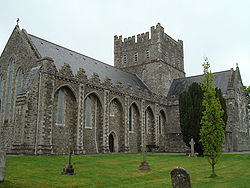Kildare Cathedral
| Kildare Cathedral | |
|
The Cathedral Church of St Brigid, Kildare | |
|---|---|
|
Kildare, County Kildare | |
| Status: | Cathedral |
 Kildare Cathedral | |
| Church of Ireland | |
| Diocese of Meath and Kildare | |
| Location | |
| Grid reference: | N72861246 |
| Location: | 53°9’28"N, 6°54’41"W |
| History | |
| Built after 1223 | |
| Irish Gothic | |
| Information | |
The Cathedral Church of St Brigid, Kildare, known as Kildare Cathedral stands prominently in Kildare, County Kildare and is one of two cathedrals of the Diocese of Meath and Kildare in the Church of Ireland, part of the Province of Dublin.
History
Early history
Legend has it that in the year 480 (35 years after St Patrick settled in Armagh) St Brigid arrived in Kildare with her nuns. (Brigid is a very popular saint in Irelad, thiough quite likely to be fictional.) This original abbey church may have been a simple wooden building. Soon after Brigid's death, said to have been in 523, a costly shrine was erected in her honour in a new and larger building.
For many centuries Kildare maintained a unique Irish experiment; the Abbess ruled over a double community of women and men, and the Bishop was subordinate in jurisdiction to the abbess.
Between the years 835 and 998 the cathedral was devastated approximately 16 times, so that when the Norman, Ralph of Bristol, became bishop in 1223 it was virtually in ruins. Between then and 1230 it was largely rebuilt, likely in the years following 1223, and probably by Ralph of Bristol who was made Bishop of the see in 1222 and died in 1232.
Still semi-ruinous by 1500, the cathedral was derelict by 1649. In 1686 it was partially rebuilt.
Demise and resurrection
The Cathedral fell into disrepair following the 16th century Reformation, and was ruined during the 17th century Irish Confederate Wars.[1]
A near complete restoration of the building was undertaken during the 19th century by George Edmund Street[2] He started restoration work on the Cathedral in 1875, and work continued after his death in 1881 until it was complete in 1896. These works included a new north trancept, new chancel, and new west wall as well as rebuilding three sides of the square tower. A new oak roof (which is supported on stone corbels) was built into the wall buttresses.
As part of the centenary, the Cathedral underwent further restoration including new internal porches, repairs to internal and external stonework and rebuilding of the organ.[3]
Current status and layout
Previously the cathedral of the Diocese of Kildare, it is now one of two cathedrals in the 'United Dioceses of Meath and Kildare, along with Trim Cathedral.
The present building is a restored Norman cathedral dating from 1223. The site occupied by the cathedral is likely the site of a pagan shrine to the goddess Brigid and the later of the church of St Brigid. A perpetual flame was kept here from pre-Christian times possibly until the time of Henry VIII, under whom superstitious practices were rooted out across the the Churches of Ireland and England.[4][5]
Beside the cathedral stands one of County Kildare's five round towers which stands 105 feet high, and which can be climbed at certain times.
The cathedral is cruciform in plan without aisles in the early gothic style with a massive square central tower. All the windows are lancet windows, singles or doubles, but triple lancets in the four gables. Design features include arches which span between buttress to buttress in advance of the side walls. The parapets are of the stepped Irish type (now much restored) but probably datable to c. 1395, the year in which a Papal relaxation was given to those who visited Kildare and gave alms for the conservation of the church. The interior treatment is plain, the window splays are not moulded, but the rear-arches, which are, spring from shafts with moulded capitals. These shafts are short and terminate in small curved tails.[6]
Features
Features of the Cathedral include:
- An altar-tomb effigy of Bishop Walter Wellesley (died 1539) which is an example of 16th century sculpture
- A Sheelagh-na-gig (erotic carving), which is unusual to find in cathedrals
- Solid oak stalls for the choir and chapter with acorn and oak leaf carvings
- The Bishops throne
- A high-altar area with reproductions of the mediæval originals
- Carved Caen Stone pulpit with carvings of the four evangelists and Irish marble columns
- The Lady Chapel
- The organ which was built by Conacher in 1898
- St. Luke stained glass window by Gerda Schurmann dated 1974
- A stone font which is not original to the Cathedral but is dated from the Middle Ages
- The west window, dedicated to St. Patrick, St. Brigid and St. Columba
Gallery
-
Eagle Lectern
-
Nave
-
Tomb of Walter Wellesley
References
- ↑ Day, J.G.F and Patton, H.E.: 'The Cathedrals of the Church of Ireland', p 99: (SPCK, 1932)
- ↑ Memoir of George Edmund Street, R.A., b.1824-d.1881, Arthur Edmund Street.
- ↑ Kildrae History: The Cathedral
- ↑ "Lighting the Perpetual Flame of Brigid (A brief history of the flame)". Jan 2006. Archived from the original on 30 May 2015. https://web.archive.org/web/20150530123107/http://kildare.ie/community/notices/perpetual-flame.asp.
- ↑ "St. Brigid's Fire Temple". Archived from the original on Sep 13, 2015. https://web.archive.org/web/20150913011342/http://www.kildare.ie/community/easysites/kildareheritage/?page_id=44.
- ↑ Leask, Harold G. MArch, Litt.D., M.R.I.A., F.S.A., F.R.S.A.I., F.R.I.A.I.: 'Irish Churches and Monastic Buildings' – Volume II
| Cathedrals of the Church of Ireland |
|---|
|
Province of Armagh:
Armagh •
Clogher •
Derry •
Downpatrick •
Dromore •
Elphin •
Enniskillen •
Killala •
Kilmore •
Lisburn •
Raphoe •
Sligo •
Tuam •
Belfast
|


